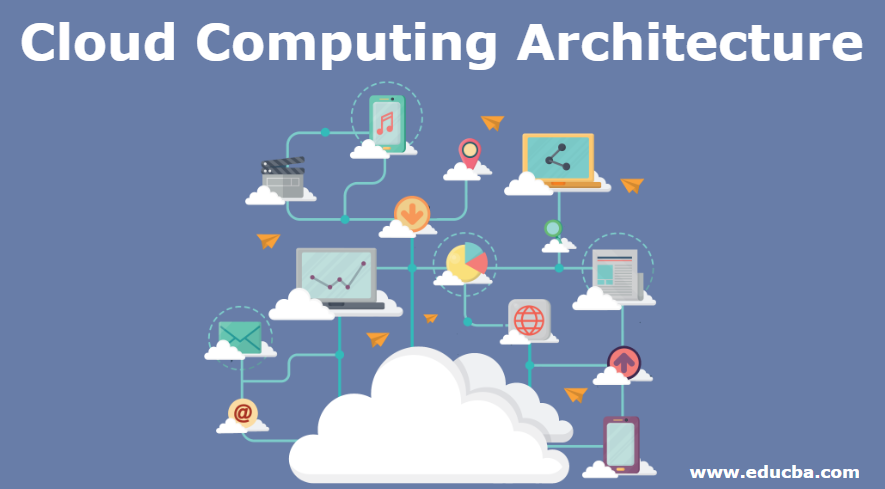Updated March 20, 2023
Introduction to Cloud Computing Architecture
The following article, Cloud Computing Architecture, provides an outline of the architecture of cloud computing. Technology is advancing, and it’s true. Cloud computing is one of those emerging technologies needing to store data and provide scalable services in its field.
Coming into the major focus area of computing is:
- SOA (Service Oriented Architecture)
- Virtualization of software and hardware components
- Grid Computing
- Utility computing
Its basic concern is to share resources among all cloud service consumers, clients, and open source communities like Red Hat. Moreover, sharing of resources is done at various cloud hierarchies or levels such as infrastructure cloud, software cloud, application cloud, and business cloud. A major goal of all these types of cloud and sharing is resource management and effective budget management, thus giving good potential to the overall business. Users do not require any special knowledge for connecting their computer systems with servers so that we can think of the internet as a metaphor for cloud computing. Cloud computing is a type of on-demand IT service model that demands virtualization and distributed systems with computational technologies.
The architecture of Cloud Computing
Architectures for Cloud Computing have the following characteristics:
- Simultaneous Provisioning
- Flexible and Scalable
- Demanding service, i.e. ‘Service on Demand,’ usually with a billing and monitoring system.
- Management of programs like through WS API.
- Abstracted Resource.
- Instantaneous sharing of resources like hardware, software, database, etc.
There are many types of components for a good cloud architecture which are loosely coupled, but we will categorize them into two major segments:
- Front End
- Back End
As mentioned, the Internet is a metaphor for our cloud computing technology. Here comes the proven fact that for each End, a proper network is required for communication. This architecture depicts the end to end flow for front end and backend communication via a network that is acting as an interface here.
Diagram of Cloud Computing Architecture
Note: Cloud Architecture and Cloud Infrastructure both have different components and concepts. Cloud Architecture describes a high-level overview of client and server communicate via a network, whereas Cloud Infrastructure tells about the servers, storage, virtualization, and various services.
- As depicted, the cloud architecture consists of Front End and Back End both. Therefore, the first thing that comes into our mind is what is this or how this architecture is solving our complex resource sharing problem.
- Let’s walk through this architecture; the client-side or the front end will be like meeting with the web applications or the interfaces of the applications having the protocols and ports configured for accessing and interaction between the user and database can say cloud computing platform. E.g. Web Browser.
- Back End refers to the cloud itself. It comprises of resources providing cloud computing services. It consists of all the necessities like big data storage, security, virtual machines.
- All applications being hosted on the back end of the cloud premises are secured because of the built-in security of the mechanism, traffic control, and protocols.
- These Protocols are the mediators or the middleware to establish successful communication with each other.
- If we bring our focus into the cloud infrastructure, which has all abilities of server management, hypervisor, network, server, and storage will provide a good aid to the entire project, i.e., it is very good for project management.
- It has a concept of hypervisor, which plays quite a pivotal role in the sense, it helps in creating a lot many microservices without providing the entire load on the Operating system rather, than that hypervisor will help by creating lightweight microservices on top of it like Containerization techniques docker, Kubernetes, OpenStack to be created for the virtual machine one of another effective way of resource management and sharing.
There are some constraints which every cloud infrastructure should experience like:
- Transparency: This can be obtained using resource sharing example, Virtualization.
- Scalability: Basically deals with the provisioning and de-provisioning on an everyday basis.
- Security: The data center should be secured as build-in security is already being there.
- Intelligent Monitoring: To achieve all the above functionality, it is very much needed to be capable of intelligent monitoring.
Conclusion
At last, the overall zest that comes from the cloud computing paradigm and its architecture is that it has to be made to work as a utility, which should have the potential to transform a large part of the IT industry, making the entire IT as much attractive as possible so that developers with innovative ideas should not be dependent on the hardware to deploy their service or the human expanse to operate it.
There is no need to pay any huge amount of premiums for project management, and full automation with the latest technology can be performed without any hindrance. Therefore, a conclusion and some of the future work can be made like it can help all the communities and folks by lowering the cost and simplifying the delivery of cloud services. Future research may include more new attitudes and strategies regarding the migration of cloud solutions and develop more cloud solutions according to the need.
Recommended Articles
This has been a guide to Cloud Computing Architecture. Here we discuss the architecture of cloud computing along with the block diagram with a detailed explanation. You can also go through our other suggested articles to learn more –



